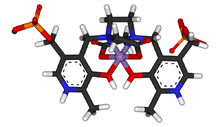Mangafodipir
 | |
 | |
| Clinical data | |
|---|---|
| AHFS/Drugs.com | Micromedex Detailed Consumer Information |
| |
| Intravenous infusion | |
| Pharmacokinetic data | |
| Bioavailability | NA |
| Protein binding |
27% (manganese) Negligible (DPDP) |
| Half-life |
20 minutes (manganese) 50 minutes (DPDP) |
| Excretion |
Renal and fecal (manganese) Renal (DPDP) |
| Identifiers | |
|
119797-12-5 | |
| V08CA05 | |
| PubChem | CID 3086672 |
| ChemSpider |
2343239 |
| UNII |
N02W67RKJS |
| ChEMBL |
CHEMBL1628235 |
| Chemical data | |
| Formula | C22H28MnN4O14P2 |
| 689.362 g/mol | |
|
SMILES
| |
| |
| | |
Mangafodipir (sold under the brand name Teslascan as mangafodipir trisodium) is a contrast agent delivered intravenously to enhance contrast in magnetic resonance imaging (MRI) of the liver. It has two parts, paramagnetic manganese (II) ions and the chelating agent fodipir (dipyridoxyl diphosphate, DPDP). Normal liver tissue absorbs the manganese more than abnormal or cancerous tissue. The manganese shortens the longitudinal relaxation time (T1), making the normal tissue appear brighter in MRIs. This enhanced contrast allows lesions to be more easily identified.
Teslascan was withdrawn from the US market in 2003[1] and the European market in 2012.[2]
References
- ↑ "January 2005: Additions and Deletions to the Drug Product List". U.S Food and Drug Administration.
- ↑ "Teslascan (mangafodipir): Withdrawal of the marketing authorisation in the European Union" (PDF). European Medicines Agency.
| ||||||||||||||||||||||||||||||||||||||||||||||||